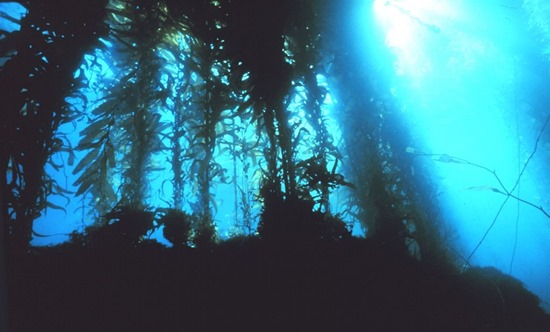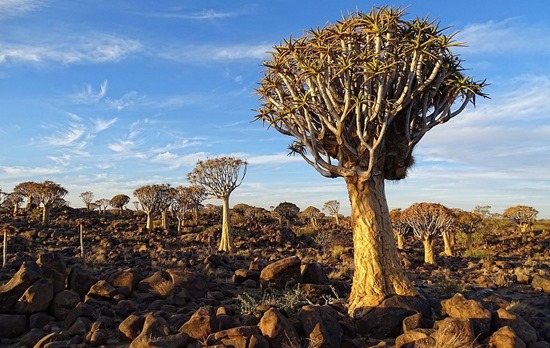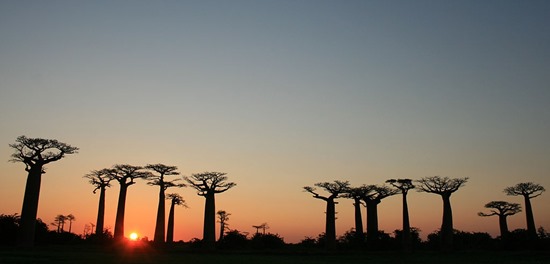
Whether they're thriving underwater or in a desert, these unusual forested ecosystems buck convention.
1. Kelp Forest
When you think of forests, the images that typically come to mind involve a group of terrestrial wooden behemoths shooting upwards into the sky. Forests are not merely confined to dry land, though - they can also occur underwater.
One of the best examples of this are kelp forests, which you can find in abundance throughout the world's oceans. These dense proliferations of nutrient-rich seaweed offer vital marine habitats to a variety of wildlife, and they've been harvested by humans for millennia.
Of course, these kelp ecosystems aren't the only example of a forest that bucks convention. Here are just a few more unusual forests found on Earth.
2. Quiver Tree Forest
Deserts hardly seem like the appropriate place for a forest, and yet, here we have the Quiver Tree Forest of southern Namibia.
Quiver trees (Aloe dichotoma) are named for their hollowed branches, which have been historically used by bushmen as quivers for their arrows.
There are about 250 specimens living in this sparse forest, and the largest individuals in the bunch are between 200 and 300 years old.
3. Mangrove forests
Photo: NOAA National Ocean Service
Rooted beneath the water like seaweed yet stretching out into the sky like a terrestrial plant, mangroves are like the mermaids of forest ecosystems.
You'll typically find these picturesque shrub-like trees along the coasts of the tropics and subtropics, where they proliferate in habitats known as "mangals."
They are able to thrive in brackish water thanks to their unique salt filtration abilities, and rough ocean wave movements are no trouble for them thanks to their deep root system.
4. Methusaleh Grove
Situated in California's Inyo National Forest, this grove of Great Basin bristlecone pines (Pinus longaeva) was named after one of its oldest residents, Methusaleh, which is now a whopping 4,847 years old.
The species is distinguished not only for its mind-boggling longevity, but also for its gnarled, witch-like appearance. With their stunted looks and surrounding scrubby landscape, visiting a high-altitude "forest" of these trees is a far cry from your typical forest experience.
Although Methusaleh's age usually dominates headlines and trivia nights, scientists actually discovered an even older bristlecone pine (5,065 years old) in the same area back in 2012. Both trees' locations remain a secret for their protection.
5. Sunken forest of Kaindy Lake
Unlike many of the other unusual forests on our list, the sunken forest of Kazakhstan's Kaindy Lake is not technically a living forest. Not anymore, at least!
This patch of forest once stood on dry land, but that changed in 1911 when an earthquake triggered a landslide of the surrounding slope. The resulting debris flow formed a dam that has been trapping rain water ever since.
Today, the lake is 1,300 feet long, and the trees that once stood in the area have succumbed to rising waters. Over the years, exposure from the elements has reduced the dead trees to mere wooden poles, though remnants of their dense branch systems still exist beneath the surface of the water.
6. Deadvlei
Namibia's Deadvlei ("dead marsh" in Afrikaans) was once a fertile desert clay pan, but some 900 years ago it began drying up after encroaching sand dunes cut it off from the Tsauchab River.
The trees that lived within the dwindling marsh eventually died, and though centuries have passed, they have yet to decompose because it's just too dry.
The resulting image - a spindly, dark forest of 1,000-year-old trees set against the orange dunes and white flats - is one of the most surreal sights you'll find in Africa.
7. Avenue of the Baobabs
Situated near the western coast of Menabe, Madagascar, this Malagasy treasure lays claim to being one of the country's most popular tourists destinations.
The oldest of these towering baobabs date back 800 years, when the land surrounding them was a dense and lush rainforest.
That was then, this is now.
After decades of unchecked deforestation and agricultural development, these thick-trunked trees now stand as stark sentinels overlooking the increasing encroachment of rice paddies and sugarcane fields.
8. Crooked Forest
This unnaturally curved grove of 400 pine trees was planted sometime around 1930, just outside the town of Nowe Czarnowo in West Pomerania, Poland.
Nobody is 100 percent sure what mechanism caused these trees to form into their odd shape, though it is generally agreed to be the result of human intervention.
To this day, the method and tools used to create the Crooked Forest are unknown, but the reason for their intentional deformation was likely to produce naturally curved timber for furniture and ship building.
9. Dragon Blood Trees
With their umbrella-shaped canopies, tightly gnarled limbs and freakishly red sap, Yemen's famous dragon blood trees (Dracaena cinnabari) look like something straight out of a science fiction novel featuring alien planets. Rest assured, however, these fantastical plant organisms are unequivocally the product of Earth.
Sadly, these trees are becoming increasingly vulnerable as the island of Socotra becomes more arid due to climate change.
According to Globaltrees.org, dragon blood trees "can expect to lose 45 percent of its potential habitat by 2080. [...] Unless major steps are taken to mitigate climate change soon, the future of Socotra’s iconic and ancient Dragon tree - along with countless other species around the world - is very much in doubt."









No comments:
Post a Comment
Please adhere to proper blog etiquette when posting your comments. This blog owner will exercise his absolution discretion in allowing or rejecting any comments that are deemed seditious, defamatory, libelous, racist, vulgar, insulting, and other remarks that exhibit similar characteristics. If you insist on using anonymous comments, please write your name or other IDs at the end of your message.